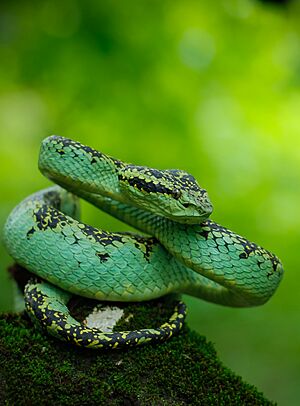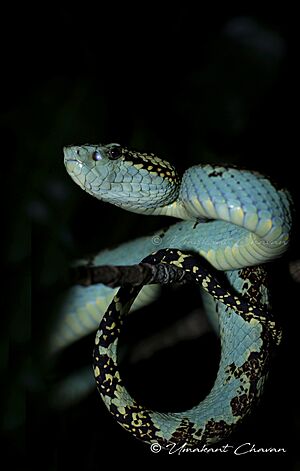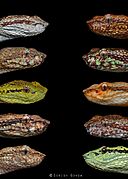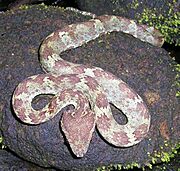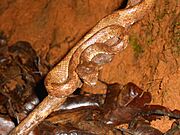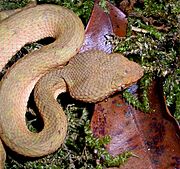Craspedocephalus malabaricus facts for kids
Quick facts for kids Craspedocephalus malabaricus |
|
|---|---|
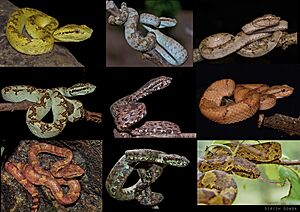 |
|
| Color morphs of Craspedocephalus malabaricus | |
| Conservation status | |
| Scientific classification | |
| Genus: |
Craspedocephalus
|
| Species: |
malabaricus
|
| Synonyms | |
|
List
|
|
The Craspedocephalus malabaricus, often called the Malabar pit viper, is a type of venomous snake. It is also known as the Malabar rock pit viper or just rock viper. This snake lives only in the high mountains of the Western Ghats in southwestern India. Recently, scientists divided this snake group into three different species. These are Craspedocephalus malabaricus, Craspedocephalus travancoricus, and Craspedocephalus anamallensis.
Contents
About the Malabar Pit Viper
What Does the Malabar Pit Viper Look Like?
Adult Malabar pit vipers can grow up to about 105 cm (41 in) long. This measurement is from their snout (nose) to their vent (a small opening near the tail). Their tail can grasp things, which helps them move through trees.
These snakes come in many different colors. You might see them in yellow, green, or brown. Sometimes they have interesting patterns on their skin.
Where the Malabar Pit Viper Lives
Habitat and Location
The Malabar pit viper is found only in the Western Ghats mountains. This mountain range is located in southern and western India. These snakes live at elevations between 600–2,000 metres (2,000–6,600 ft) (about 2,000 to 6,500 feet).
You can find them in places like the Silent Valley, western Nilgiris, Wayanad, and Coorg. They also live in the Malnad region of Karnataka, Castle Rock, Goa, and north into Maharashtra. They prefer forests near rivers and streams. They are often seen on rocks in stream beds or on low plants and bushes. These snakes like dense, wet rainforests, and sometimes evergreen or deciduous forests.
Malabar Pit Viper Behavior
Daily Life and Diet
The Malabar pit viper is a nocturnal animal. This means it is most active at night. During the day, it usually rests. You might see it basking (sunbathing) on rocks or trees near streams. They are more often seen during the monsoon months, which is the rainy season.
This snake is a hunter. It eats small animals like frogs and lizards. It also preys on baby birds, musk shrews, mice, and other small creatures.
Malabar Pit Viper Venom
Understanding Its Bite
The Malabar pit viper moves slowly most of the time. However, it can strike very quickly if it feels threatened. Its venom can cause pain and swelling in humans. These symptoms are usually not severe. They typically go away within a day or two.



